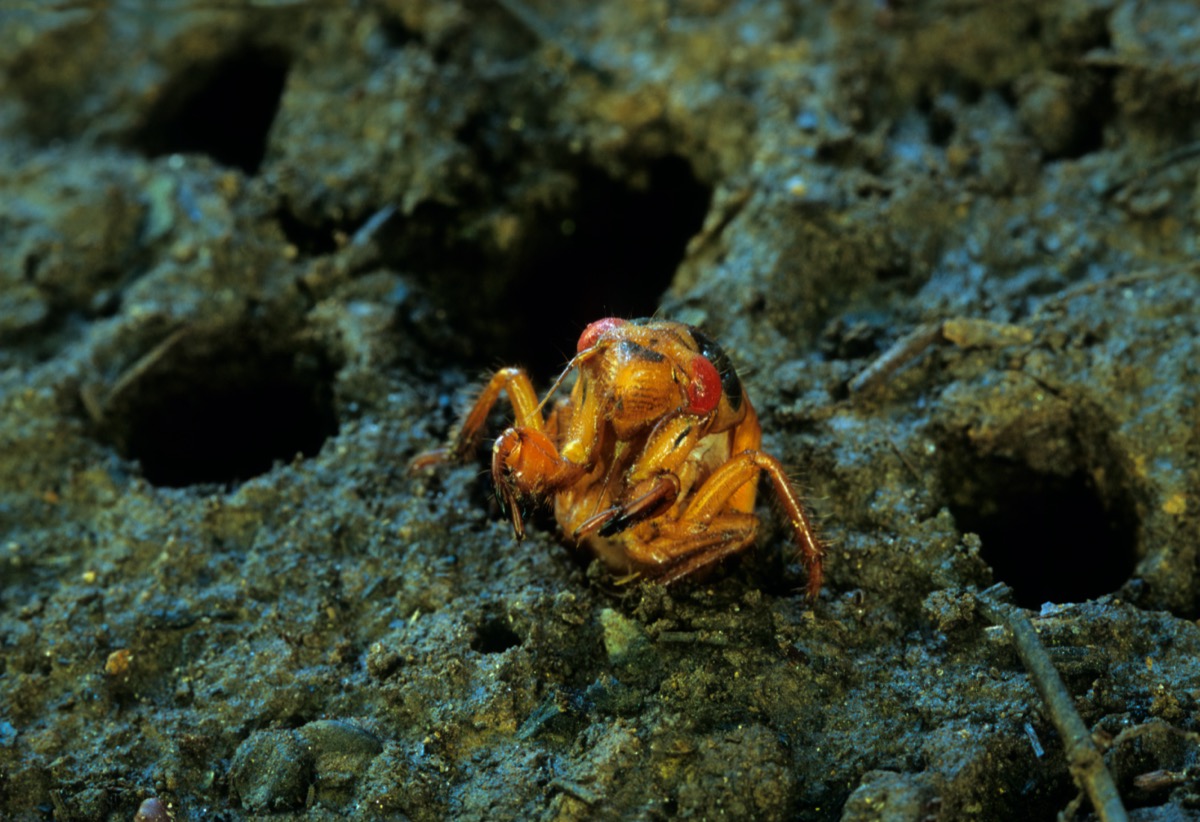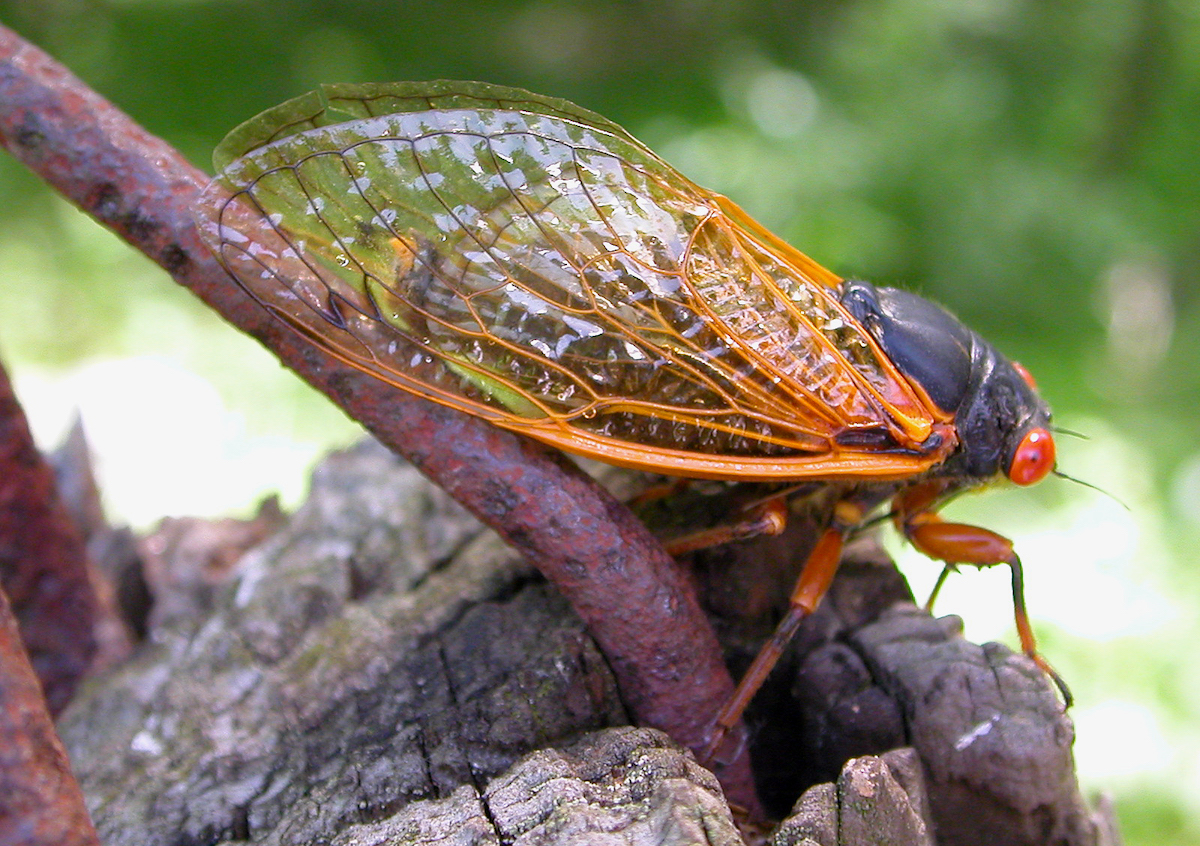This Rare Insect Phenomenon Could Start Happening More Often

In just a few weeks, droves of cicadas will rise from their 17-year slumber and begin infesting 15 states in the U.S. The phenomenon, referred to as Brood X, will result in trillions of cicadas emerging from the ground in search of a mate. As of right now, Brood X cicadas are only set to emerge every 17 years, as they have for ages, but experts say there are signs that indicate they may begin emerging more frequently. Read on to learn why these bugs may begin appearing more often, and for more insect insight, If You See This Bug in Your Home, Don’t Step on It, Experts Warn.
Experts predict the Brood X cicadas may start to emerge more frequently.

Scientific American noted that the reemergences of cicada broods are some of nature’s most on schedule events. Humans have been documenting the rise of these insects for hundreds of years. However, lately the reemergences seem to be shifting over time. While early emergences have been documented before, it appears to be happening more frequently now. Gene Kritsky, PhD, a cicada expert at Mount St. Joseph University in Ohio, told Scientific American that there’s been a spree of early risings in recent years among cicada broods, including a small segment of Brood X cicadas that emerged four years early in 2017 in the Washington, D.C., area.
There are 15 periodical broods that arise at different intervals, according to Scientific American. Experts predict the timing of these reemergences may shift and become more frequent. And for more on the exact date of Brood X’s return, This Is Exactly When Trillions of Cicadas Will Emerge After 17 Years.
Climate change may be to blame.

Scientists predict that climate-related factors may play a role in why the cicadas are emerging out of sync. Per Scientific American, if climate change is to blame for the shift in cicadas’ timing, experts say it could cause long-term changes in the 15 broods. “This is happening all the time now,” Kritsky told ClimateWire. He has seen cicadas emerge early in multiple broods all over the east coast for years. “These accelerations that we’re seeing constantly for all these different broods over much of the eastern half of the U.S., the only common phenomenon that can account for it is climate,” Kritsky added.
Chris Simon, PhD, a professor in the University of Connecticut’s Ecology and Evolutionary Biology Department, speculated in a Washington Post opinion piece that climate change affects the cicadas. “Is climate change allowing 17-year cicadas to grow up faster? Will these four-year-early events continue to increase in number and intensity? Will they affect the size of 17-year broods?” Simon wondered. She added that if the climate continues to warm, the 17-year cicadas could shift to 13-year intervals and potentially even nine-year cycles eventually. When cicadas emerge early, it tends to be by four years, as Scientific American notes, although it’s unclear why. And to find out which states will face the biggest onslaught of cicadas, If You Live Here, Prepare for a Major Bug Infestation, Expert Warns.
The warmer weather can potentially cause cicadas’ signals to get crossed.

According to Scientific American, scientists believe that cicadas use cues from the roots of trees they feed on to help them keep track of the years while they’re underground. “These plants lose their leaves in the fall and grow new ones in the spring,” John Cooley, PhD, a cicada expert at the University of Connecticut, told Scientific American. “So there must be a host of different signals going on and indications in the plants of what’s going on.” Scientists assume that something must occur to throw off the count and cause the cicadas to emerge early.
Cooley noted that false springs could be to blame. Trees leafing early in the warmer weather could trick cicadas into thinking more than one year has passed. If Cooley is correct, then early emerging could begin to happen more often, as spring comes earlier across much of the U.S. along with climate change, Scientific American reports. And for more fascinating information delivered straight to your inbox, sign up for our daily newsletter.
The broods could also move into new territories.

If you’ve never experienced a cicada reemergence in your home state, that could change. Brood X cicadas are currently only found in 15 states. However, Simon noted that as the climate shifts, the insects’ habits could as well. “By midcentury, the climate of Connecticut is predicted to be similar to that of North Carolina now. Will the cicadas there move north? Will they once again thrive in New England and southern Wisconsin, where they are currently extinct? These are the questions evolutionary biologists are asking,” Simon wrote. And for insects that are closer to home, If You Smell This in Your Bedroom, You Might Have Bed Bugs.